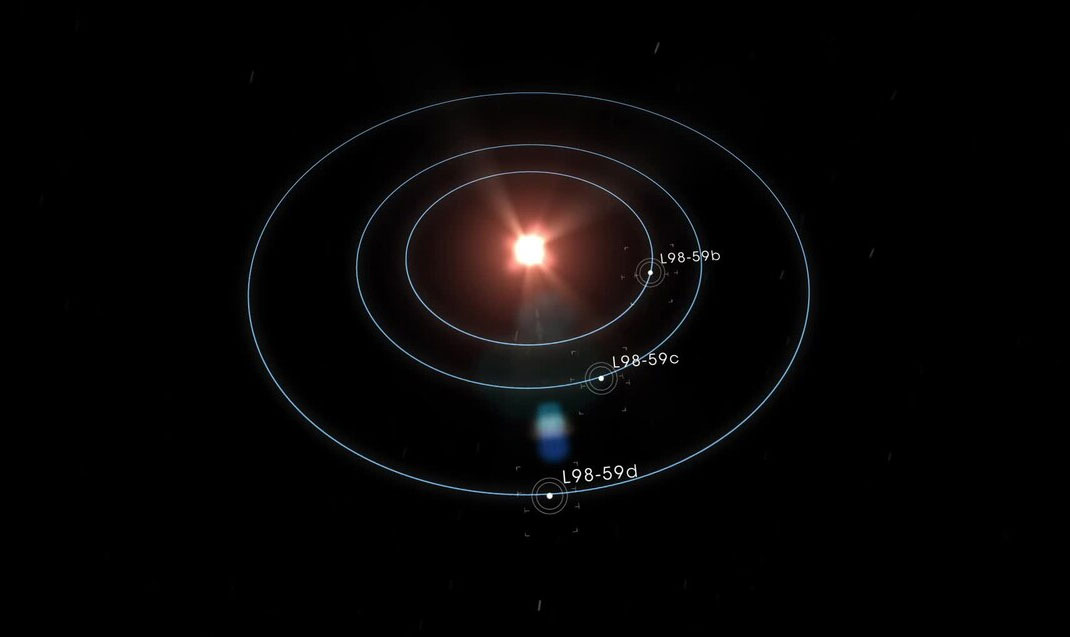Earth-like planet discovered just 35 light years away, may have life
Scientists have confirmed a fifth potentially habitable planet in the L 98-59 system, revealing a diverse collection of rocky worlds that may harbor water or volcanic activity.
A team from the Trottier Institute for Exoplanet Research (IREx) has completed the most detailed investigation to date of the planetary system around L 98-59, a nearby red dwarf star. Their analysis confirmed a fifth planet in the star's 'habitable zone' – the region where conditions could support the presence of liquid water.
The red dwarf L 98-59, located just 35 light-years from Earth, hosts three small exoplanets, first discovered in 2019 by NASA's TESS space telescope. A fourth planet was later identified using radial velocity data collected by the European Southern Observatory's (ESO) ESPRESSO spectrograph. The four planets orbit extremely close to their host star, each on an orbit much shorter than Mercury's orbit around the Sun.

Led by Professor Charles Cadieux from the Université de Montréal (UdeM) and IREx, the team re-examined a huge amount of data from both ground-based and space-based telescopes. This effort allowed them to measure the size and mass of the planets with unprecedented precision.
' These new results paint the most complete picture we have ever had of the fascinating L 98-59 system ,' said Professor Cadieux. ' It is a powerful demonstration of what we can achieve by combining data from space telescopes and high-precision instruments on Earth, providing us with prime targets for future atmospheric studies with the James Webb Space Telescope [JWST] '.
All of the planets in the system have masses and sizes consistent with terrestrial planets. The innermost planet, L 98-59 b, is only 84% the size of Earth and about half the mass, making it one of the few known "sub-Earths" with precise measurements.
The two inner planets may experience extreme volcanic activity due to tidal heating, similar to Jupiter's volcanic moon Io in the Solar System. Meanwhile, the third planet, with its unusually low density, may be a "water world," a water-rich planet unlike anything in our Solar System.
Refined measurements revealed nearly perfectly circular orbits for the inner planets, a configuration favorable for future atmospheric detection.
One of the major breakthroughs of this research is the confirmation of a fifth planet in the L 98-59 system. The planet, designated L 98-59 f, does not transit its host star – but its existence is revealed through subtle variations in the star's motion, detected using radial velocity measurements from the HARPS instrument and ESPRESSO data.
L 98-59 f receives roughly the same amount of stellar energy as Earth receives from the Sun, placing it well within the temperate, or habitable, zone where water could exist in liquid form.
' Finding a temperate planet in such a compact system makes this discovery particularly exciting ,' said Cadieux. ' It highlights the incredible diversity of exoplanetary systems and reinforces the rationale for studying potentially habitable worlds around low-mass stars .'
Rather than spending time making observations with a new telescope, the team made these discoveries by relying on a rich archive of data from NASA's TESS space telescope, ESO's HARPS and ESPRESSO spectrographs in Chile, and JWST.
The team used a new stream-to-stream radial velocity analysis technique introduced in 2022 to dramatically improve the accuracy of the data. Combined with a new differential temperature indicator also developed by the team, they were able to accurately identify and remove the stellar activity signal from the data, revealing the planetary signal with unprecedented detail.
Combining these enhanced measurements with analysis of transits observed by JWST, the team doubled the accuracy of mass and radius estimates for known planets.
These results confirm L 98-59 as one of the most ideal systems for exploring the diversity of rocky planets, and ultimately, searching for signs of life.
The proximity, small size of the host star, and the planet's composition and orbit make it an ideal candidate for further atmospheric studies with JWST, which the IREx team has already begun.
You should read it
- NASA will launch new space telescope into space to find 'second earth'
- Top 5 planets may be our 'new houses' in the future
- 12 interesting records of planets in the universe
- The discovery of the 'Second Earth' can exist only 4.2 light-years away from Earth
- PSR B1620-26b - What's the oldest planet on the top of the 'elders' in the universe?
- New planet appears that may have life like Earth
 Microsoft is willing to pay up to $40,000 to anyone who discovers a vulnerability in .NET
Microsoft is willing to pay up to $40,000 to anyone who discovers a vulnerability in .NET Some features in Microsoft Office will stop working if not updated.
Some features in Microsoft Office will stop working if not updated. Reddit moves into search engine space
Reddit moves into search engine space Microsoft reveals why computers are blocked from upgrading from Windows 10 to Windows 11
Microsoft reveals why computers are blocked from upgrading from Windows 10 to Windows 11 Gemini takes users straight to a scam site after web search
Gemini takes users straight to a scam site after web search Microsoft bans LibreOffice developer account without warning, rejects appeal
Microsoft bans LibreOffice developer account without warning, rejects appeal